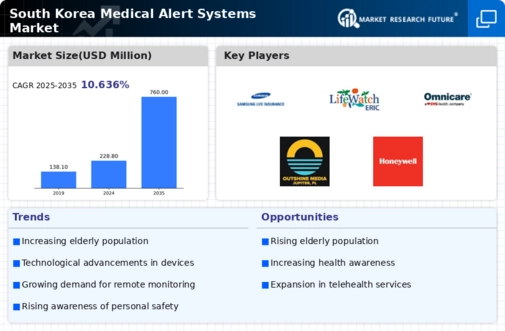The medical alert-systems market exhibits a dynamic competitive landscape, characterized by rapid technological advancements and an increasing focus on user-centric solutions. Key players such as Philips (NL), Life Alert (US), and ADT (US) are actively shaping the market through strategic initiatives aimed at enhancing service delivery and expanding their market presence. Philips (NL) emphasizes innovation in its product offerings, particularly through the integration of advanced health monitoring technologies, which positions the company as a leader in providing comprehensive health solutions. Meanwhile, Life Alert (US) focuses on maintaining a strong brand reputation through effective marketing strategies and customer service excellence, which appears to resonate well with its target demographic. ADT (US), on the other hand, leverages its extensive experience in security systems to offer integrated solutions that combine safety and health monitoring, thereby appealing to a broader customer base.
The business tactics employed by these companies reflect a concerted effort to optimize operations and enhance customer engagement. Localizing manufacturing processes and optimizing supply chains are prevalent strategies that not only reduce operational costs but also improve responsiveness to market demands. The competitive structure of the market is moderately fragmented, with several players vying for market share, yet the influence of major companies remains substantial, shaping industry standards and consumer expectations.
In October 2025, Philips (NL) announced the launch of a new line of wearable medical alert devices that incorporate AI-driven health analytics. This strategic move is significant as it not only enhances the functionality of their products but also aligns with the growing trend of personalized healthcare solutions. By leveraging AI, Philips aims to provide users with real-time health insights, potentially improving response times during emergencies and fostering greater user trust in their systems.
In September 2025, Life Alert (US) expanded its service offerings by introducing a mobile application that allows users to connect with emergency services directly from their smartphones. This development is crucial as it reflects the increasing importance of mobile technology in the medical alert sector. By enhancing accessibility and convenience, Life Alert positions itself to capture a larger share of the tech-savvy demographic, which is increasingly seeking integrated solutions that fit their lifestyles.
In August 2025, ADT (US) entered into a strategic partnership with a leading telehealth provider to integrate remote health monitoring services into its existing security systems. This collaboration is indicative of a broader trend towards convergence in the healthcare and security sectors, suggesting that consumers may increasingly prefer comprehensive solutions that address multiple aspects of safety and health. Such partnerships could enhance ADT's value proposition, making it a more attractive option for consumers looking for holistic solutions.
As of November 2025, the competitive trends in the medical alert-systems market are heavily influenced by digitalization, sustainability, and the integration of AI technologies. Strategic alliances are becoming more prevalent, as companies recognize the value of collaboration in enhancing service offerings and expanding market reach. Looking ahead, competitive differentiation is likely to evolve from traditional price-based competition towards a focus on innovation, technological advancements, and supply chain reliability. This shift underscores the necessity for companies to invest in R&D and forge strategic partnerships to remain competitive in an increasingly complex market.
















Leave a Comment